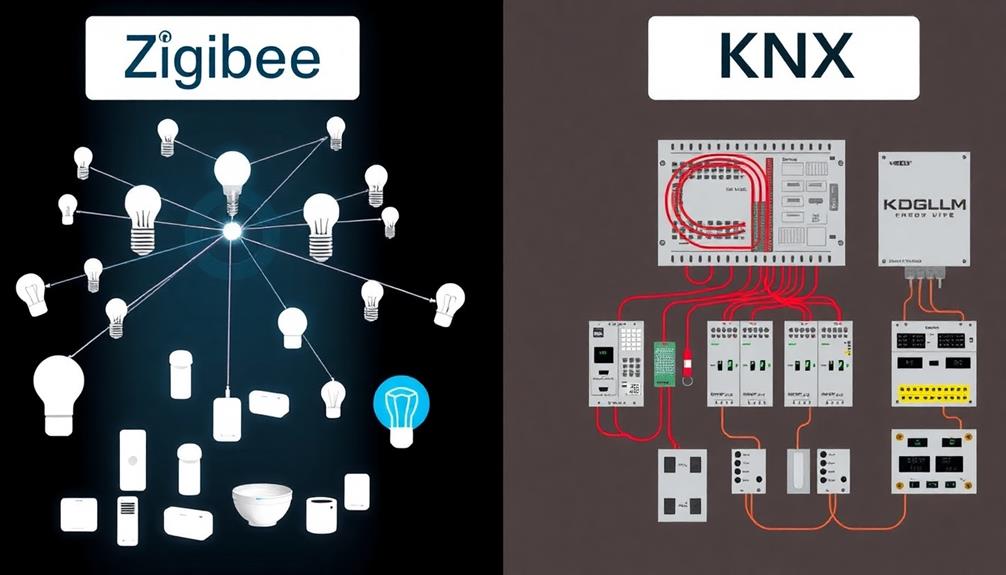When comparing Zigbee and KNX, you'll notice key differences in functionality and application. Zigbee shines in small, battery-operated devices and DIY setups due to its low installation costs and easy expansion. It uses a mesh topology for flexible communication. In contrast, KNX excels in large-scale settings, offering robust, wired connections but requiring professional installation and more complex programming. While both systems emphasize security, they cater to unique environments—Zigbee for homes and KNX for commercial applications. Understanding these distinctions can help you choose the right system for your automation needs. Stick around to explore more about each technology!
Key Takeaways
- Zigbee utilizes a mesh topology for flexible, easy-to-expand networks, while KNX employs a bus topology for stable, wired connections.
- Zigbee is more cost-effective and DIY-friendly for smaller installations, whereas KNX incurs higher upfront costs requiring professional installation.
- Security features differ; Zigbee uses AES-128 encryption, while KNX relies on KNX Data Secure for data protection.
- Zigbee excels in residential applications, while KNX is better suited for extensive commercial and industrial environments.
- Interoperability challenges arise due to differing protocols and data formats, often requiring gateways for integration between Zigbee and KNX systems.
Overview of Zigbee and KNX

When it comes to smart home automation, Zigbee and KNX stand out as two popular communication protocols, each with unique strengths.
Zigbee excels in low power consumption, making it perfect for battery-operated devices. It operates on the IEEE 802.15.4 standard, which is specifically designed for short-range, low-data rate communications.
On the other hand, KNX is a wired standard that also supports wireless options. It focuses on interoperability and reliability, ideal for extensive building automation systems.
Understanding these protocols is vital for designing effective automation systems, as they differ markedly in performance, application areas, and installation requirements.
Network Topologies Explained

Network topologies play an important role in how devices communicate within smart home systems.
Zigbee uses a mesh topology, enabling devices to communicate directly with one another. This interconnectivity boosts reliability and extends range, making it ideal for dynamic environments.
On the other hand, KNX employs a bus topology, where devices connect through a shared line. While this setup guarantees stable communication, integrating new devices typically requires programming, which can be more complex.
Understanding these topologies helps you determine the best fit for your automation needs. Zigbee offers flexibility and easy expansion, while KNX focuses on robust integration within its predefined ecosystem.
Choosing the right topology is vital for optimizing your smart home experience.
Security Features Comparison
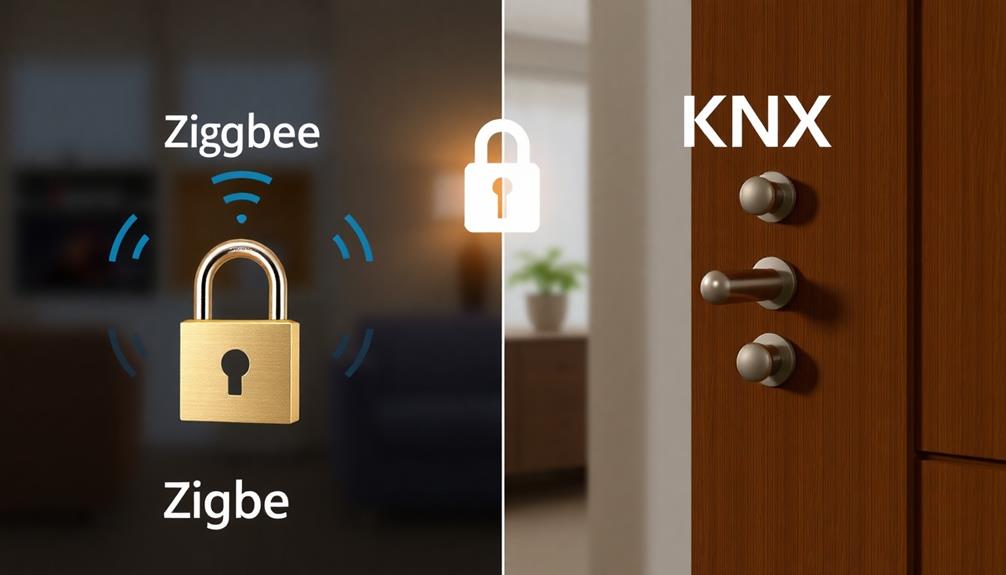
How secure are your smart home devices? When considering Zigbee and KNX, both offer strong security features, but they do so in different ways. Here's a quick comparison:
- Encryption: Zigbee uses AES-128 encryption, while KNX employs KNX Data Secure, ensuring data remains protected during transmission.
- Authentication: Each system has robust authentication methods to confirm that only authorized devices can access the network.
- Vulnerability Management: Both systems feature tamper detection and secure firmware updates to address potential security flaws.
While both protocols prioritize security, staying informed about vulnerabilities and adopting best practices is essential to keep your smart home safe.
Choose the system that aligns with your security needs for peak protection.
Installation and Configuration
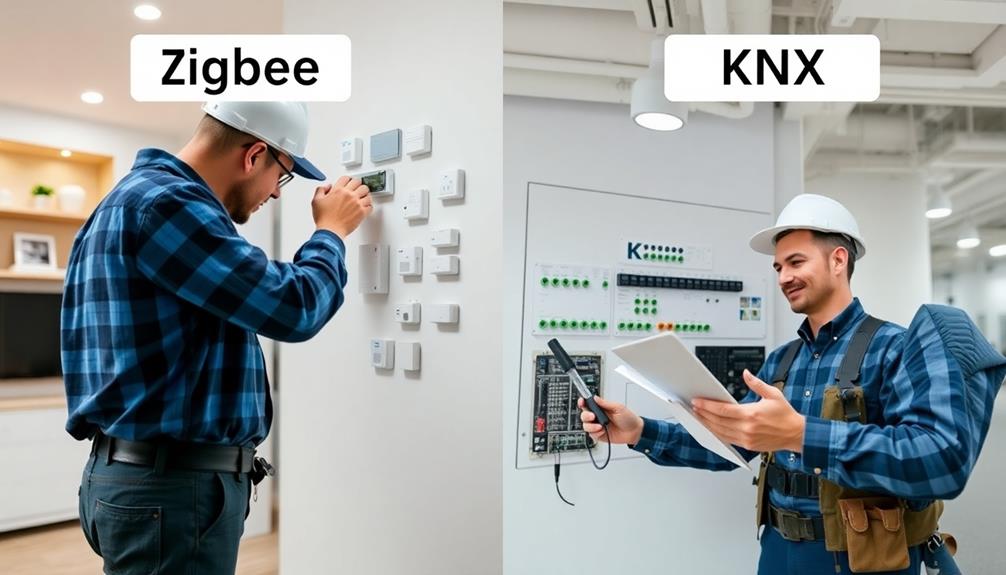
Is your smart home setup ready for the challenge of installation and configuration? When it comes to Zigbee, you're in for a treat with its straightforward, DIY-friendly wireless installation. You can easily add devices to your network without needing professional help.
On the other hand, KNX demands a more serious approach. Its wired infrastructure requires skilled technicians for installation, which can be time-consuming.
Configuration for Zigbee is user-friendly, allowing you to manage devices through intuitive apps. In contrast, KNX involves complex programming, often necessitating technical expertise.
Cost Analysis
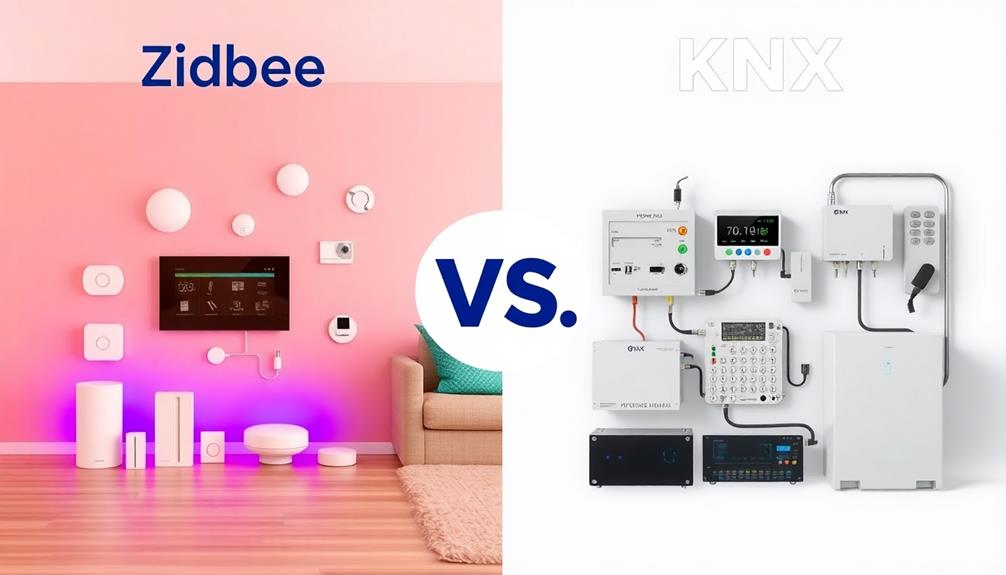
While considering the cost of implementing Zigbee or KNX in your smart home, it's essential to evaluate both initial and long-term expenses.
Here's a quick breakdown to help you navigate the financial landscape:
1. Initial Setup Costs: Zigbee tends to be cheaper for small installations since it requires minimal hardware and can often be a DIY project.
In contrast, KNX involves higher upfront costs due to professional installation and specialized components.
2. Maintenance: Zigbee systems are generally low-maintenance, while KNX may require ongoing technical support, adding to your expenses.
3. Scalability: Zigbee allows for easy expansion with added devices, making it cost-effective for future upgrades.
KNX offers robustness but can become pricey as you scale.
Understanding these factors will help you make an informed decision.
Application Areas

Numerous application areas benefit from Zigbee and KNX systems, making them versatile choices for smart home and building automation.
If you're looking to control lighting, heating, or security, both systems excel in residential environments. Zigbee's low-power capabilities make it ideal for battery-operated devices, perfect for smaller homes or DIY setups.
Meanwhile, KNX shines in larger commercial buildings, healthcare facilities, and industrial settings, providing reliable, wired connections for complex installations.
In hospitality, both systems enhance guest experiences through automated controls.
Regardless of your needs, whether for a cozy home or an expansive facility, Zigbee and KNX offer tailored solutions, ensuring efficiency and convenience in various application areas.
Interoperability Challenges
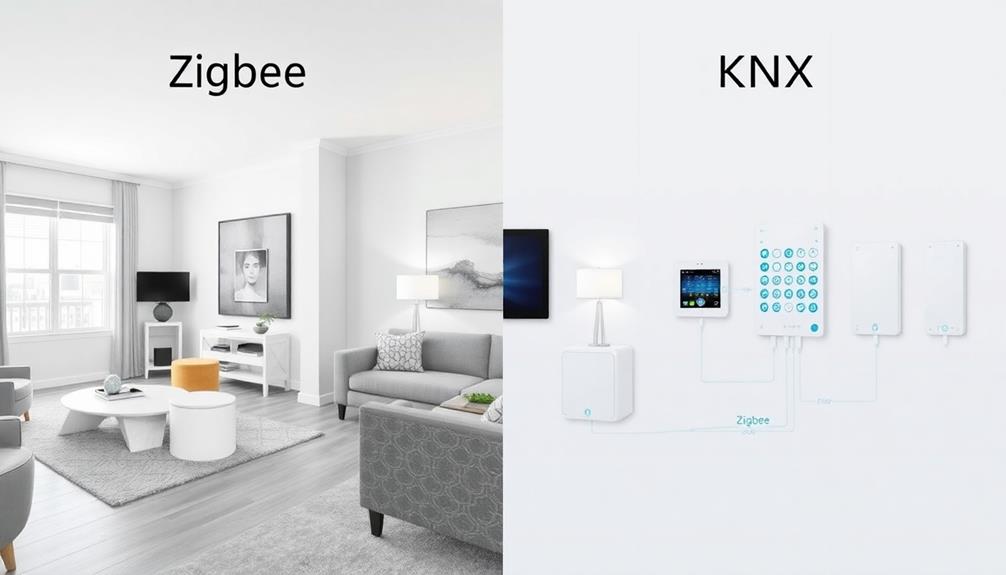
Integration of Zigbee and KNX systems can be complicated due to their differing communication protocols and data formats. This can lead to interoperability challenges that you need to navigate.
Here are a few key issues you might face:
- Protocol Mismatch: Zigbee uses a mesh topology while KNX relies on a bus topology, making direct communication difficult.
- Data Format Differences: Each system has its own data formats, which can hinder seamless data exchange between devices.
- Integration Costs: Employing gateways or middleware to bridge the two systems can add unexpected expenses to your setup.
Understanding these challenges can help you make informed decisions when designing your smart home or building automation system.
Frequently Asked Questions
What Types of Devices Are Compatible With Zigbee and KNX?
You'll find Zigbee-compatible devices like smart bulbs and sensors, perfect for home automation. KNX works with lighting, heating, and security systems, ideal for larger installations. Both enhance your smart environment considerably. Additionally, these systems can be integrated seamlessly with various advanced technologies to elevate functionality. For instance, incorporating tools like the FLIR LSXR thermal imager can enhance security setups by providing superior thermal imaging capabilities for monitoring and safety. With these versatile options, creating a cohesive and efficient smart ecosystem becomes both practical and reliable.
How Do Zigbee and KNX Handle Network Scalability?
When considering network scalability, you'll find Zigbee supports easy device expansion through its mesh topology, while KNX requires careful planning and programming for integration. Each option suits different needs depending on your project's scale.
What Are the Power Requirements for Zigbee Devices?
Zigbee devices have low power requirements, often using only a small fraction of energy compared to traditional systems. You'll find they're efficient for battery-operated applications, making them perfect for energy-conscious smart home setups.
Can Zigbee and KNX Systems Coexist in One Environment?
Yes, Zigbee and KNX systems can coexist in one environment. You can use gateway devices to bridge communication between them, allowing seamless integration and control, enhancing your smart home or building automation experience.
What Are Common Troubleshooting Tips for Zigbee and KNX Systems?
When troubleshooting Zigbee and KNX systems, remember: every cloud has a silver lining. Check device connections, reset components, verify firmware updates, and ascertain proper configuration. Don't hesitate to consult user manuals or communities for extra support!
Conclusion
In choosing between Zigbee and KNX, remember that both technologies have their strengths tailored to different needs. If you're worried about complexity and installation, Zigbee's simplicity might just be the perfect fit for your DIY projects. However, if you're considering a larger, more integrated system, KNX offers unmatched reliability and performance. Ultimately, your smart home or building automation vision can thrive with either choice—just weigh your priorities, and you'll find the best solution for your unique situation.
